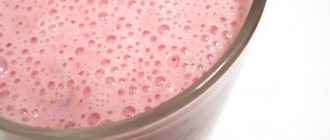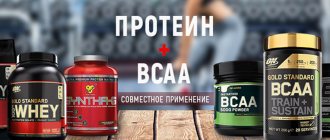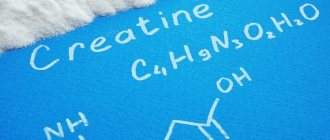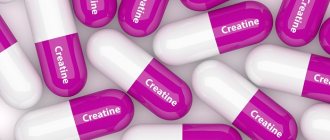When starting their sports journey, every beginner will hear a lot about different variations of sports nutrition. The most common names are “creatine” and “protein.” Even those who are completely far from sports have heard about them.
But what is hidden behind these words? Moreover, it is not entirely clear which option is better for gaining muscle? If you delve a little deeper into biochemistry, you can immediately determine the main difference. Creatine is a carboxylic acid, and its opponent is pure protein. Accordingly, these food additives have completely different types of effects on the body. Which one exactly – we’ll figure it out further.
What is protein
If creatine monohydrate takes 2nd place, protein is deservedly considered the most popular and best-selling supplement in the sports nutrition industry. Protein blends are a category of supplements that contain purified protein. The proportion of protein in them ranges from 70 to 92%. These supplements usually minimize the amount of fat and carbohydrates. Their main task is to provide the body with valuable amino acids, which are necessary for muscle growth and many biological processes.
Key benefits of protein:
- Eliminates lack of protein in the diet;
- Accelerates the growth of lean muscles;
- Reduces the destruction of muscle tissue (catabolism);
- Provides satiety, reduces hunger without consuming high-calorie foods.
- Helps reduce body fat mass.
Amino acids that come from protein foods are a necessary element not only for many processes that occur in the body. They are also necessary for maintaining muscles and motor activity.
Lack of protein in the diet leads to a huge number of negative consequences. Among the main ones:
- Muscular atrophy;
- Decreased strength and endurance;
- Muscle sagging and increased fat gain;
- Problems with skin, hair and nails;
- Weakened immunity and other consequences.
Protein consists of purified protein. Supplements are characterized by rapid absorption and allow you to get pure protein without fats, carbohydrates and extra calories. This is a great way to compensate for the insufficient amount of protein in your diet, and also get the required amount of amino acids from one serving.
In the sports nutrition industry, there are several types of protein:
- Whey;
- Egg;
- Lactic;
- Casein;
- Soy.
There is also beef protein, although it is inferior to other types in popularity. According to the form of cleaning, they are distinguished:
- Concentrate – highly purified protein, contains a minimum of carbohydrates and fats;
- Isolate is an almost completely purified raw material. Includes minimal or no carbohydrates and fats;
- Hydrolyzate is a partially digested form of protein that is almost comparable to amino acid complexes. With the exception of pronounced advantages over isolate, at a much higher cost, it is increasingly rare in supplements.
It is important to understand that protein is not a chemical additive, but a purified product that is made from whey, eggs, cottage cheese and other raw materials (depending on the type). It contains protein, but does not include various impurities. It has minimal calorie content and a fast absorption rate (in comparison with protein foods, which take 3-4 hours to digest, the supplement begins to act in 20-30 minutes). Creatine and whey protein are the most popular, effective and safe supplements in the sports nutrition industry. They have no contraindications or side effects, with a proven effect and benefit from taking them.
How to take and choose the right protein
Unlike creatine, protein can be taken on an ongoing basis. This is the most optimal and convenient way to replenish your daily protein intake, in addition to regular foods. Protein is usually taken:
- In the morning, immediately after waking up, to reduce nocturnal catabolism;
- After training – when muscles need amino acids for recovery and growth;
- At any time of the day, instead of a snack, if you cannot get the full protein requirement from regular food.
The daily protein requirement is calculated based on the formula “1.3 – 1.5 g of protein per 1 kg of muscle mass (basically, this is about 70% of body composition). During the period of weight loss, this norm increases to 2 - 2.2 g for every kg of muscle in the body. The optimal ratio of regular food and protein mixtures in the diet is 70 to 30, where 70% is food and 30% is supplements. Excessive protein consumption will not give any effect, except for increased stress on the gastrointestinal tract and kidneys.
Whey concentrate is considered the most profitable and effective option. This is the best choice in terms of price and quality ratio. Casein protein is also a popular option due to its slow digestion. It is mainly used at night to reduce muscle breakdown during sleep. The remaining types of protein, individually, are inferior in effectiveness and cost, although they are often present in complex supplements.
Sports nutrition for gaining muscle mass
Sports nutrition refers to various natural-based supplements. It is used for various purposes: building muscle mass, burning excess subcutaneous fat, increasing endurance and strength, protecting joints, and so on. The additives have a concentrated formula and are produced exclusively from natural dairy, meat and other products.
The main goal of most workouts is to gain muscle mass. The following additives can achieve this goal:
- Protein is a muscle building protein.
- BCAA complex includes essential amino acids for rapid recovery of muscle fibers.
- A gainer is a combination of carbohydrates and proteins, which together allow you to accelerate muscle gain.
- Glutamine consists of essential amino acids that promote muscle recovery and growth.
- Creatine is a carboxylic acid that improves strength, muscle volume, and energy potential.
These sports supplements are extremely popular among beginners and experienced athletes. They are not hormonal products, have a completely natural composition and are safe for use, helping to increase muscle size in a natural way.
Which is better PROTEIN or CREATINE?
What is creatine
Creatine is a carboxylic acid that is responsible for energy metabolism in muscle tissue and motor activity. The substance is synthesized in the body using three amino acids: arginine, glycine and methionine. The main task of creatine supplements is to increase ATP, which has a positive effect on increasing endurance and increasing strength.
Main effects of creatine:
- Increased strength indicators;
- Increased strength endurance;
- Improved tissue hydration;
- The ability to train longer until muscle failure due to buffering of lactic acid.
Creatine can also enhance the production of anabolic hormones and protein synthesis. Therefore, athletes often combine creatine and protein intake together to obtain a more pronounced effect.
Creatine does not directly stimulate muscle growth. It is able to positively influence protein synthesis due to increased cell hydration and improve muscle quality due to fullness. The main effect of the supplement on muscle mass is a marked increase in strength, which leads to increased lean muscle growth.
Like protein, creatine is used for mass gain. This is a natural substance that is extracted from meat products. It is produced in the body, but only in limited quantities, so to obtain a pronounced effect it must be taken from supplements. The only drawback of creatine is fluid retention in the muscles, therefore, unlike protein, creatine cannot be taken on an ongoing basis.
Methods of administration and what type of creatine to choose
There are two main schemes:
- With loading - in the first 5 days, take 4 servings (5 g each) throughout the day. Over the next 25 days, a maintenance dosage of 2-3 grams is used;
- Without loading - standard supplement intake once a day, in courses of 30-40 days, 5 g per serving.
The loading scheme is increasingly criticized, which is why doctors and sports specialists recommend using the supplement evenly from the first day of the course. It is also convenient if you use protein and creatine together, since apart from morning consumption, the rest of the time you take both supplements is the same.
Regarding the form, there are several types of additives: hydrochloride, monohydrate, citrate, malate and others. Creatine monohydrate is still considered the most beneficial and effective, especially when taken together with protein.
What are the differences between protein and creatine?
Protein and creatine are used together for mass gain. However, these are different supplements, the principle of action of which is significantly different. Protein is a protein mixture that supplies the body with amino acids, which are responsible for all the effects of the supplement. Creatine is an acid that is used in sports to increase strength and endurance. It is important to consider that creatine supplements only affect anaerobic performance, which is why they are used primarily in strength sports. Therefore, in other disciplines it is better to drink protein without creatine. In contrast, protein mixtures are indicated for any type of load and even for those who do not train (to obtain the norm of amino acids and maintain muscle tone).
Therefore, the very concept of choosing creatine or protein is considered not entirely correct. These are stand-alone supplements that are often combined due to their overall impact on training performance and progression.
Delivery throughout Russia You can order sports nutrition in the KULTURIST#1 online store anywhere in Russia. More detailed information about delivery can be found on the “Delivery and Payment” page.
Retail store addresses
#1 St. Petersburg Strike Avenue 96k3, st. m. Avtovo
#2 Novorossiysk st. Yuzhnaya, 21
#3 Sochi st. 20th Mountain Rifle Division, 18a
Gainer effect
A gainer is a sports nutrition element that contains proteins, simple or complex carbohydrates, and vitamins. Some options contain small amounts of creatine. The supplement promotes faster absorption of the required nutrients required for increasing muscle mass. Sports nutrition guarantees the restoration of energy potential and prevents the destruction of fibers during intense training.
Creatine and gainer influence the processes of muscle fiber growth, but the latter feeds absolutely all internal processes occurring in the muscles. Creatine cannot be considered a material for creating new fibers. It allows you to further increase your endurance and strength.
Both sports nutrition options complement each other well. Taking a gainer is more important for building muscle mass than creatine.
Why does Gainer help you gain mass?
How to Take Protein and Creatine Together
To maximize the benefits of supplementation synergy, it is necessary to understand how to take protein and creatine. In this case, you can achieve the maximum effect in increasing strength and muscle mass. The main reason why it is common to use creatine and protein at the same time is their synergy. To transport it to the muscles and improve the absorption of creatine, the substance requires fast carbohydrates. They lead to the release of insulin, which is the main transporter of the substance into the muscles.
Protein mixtures, due to the high degree of protein purification, also lead to an increase in insulin in the blood, which has a beneficial effect on the absorption of creatine. As a result, athletes can take both supplements together in one shaker, which is not only convenient, but also most effective.
The main joint intake on days of exercise is carried out immediately after the end of training (or within 30-40 minutes after completion of physical work). On non-training days, it can be taken at any time.
It is extremely important not to store or mix protein and creatine in the same jar. In this case, it will not be possible to determine a clear serving size for each supplement. Exceeding the dosage of creatine even 1-2 grams above the norm will lead to increased fluid accumulation and may cause swelling. Therefore, both supplements are mixed immediately before use or placed in one portion (25-30 g for protein mixtures and 5 g of creatine) in a container for dry supplements in a shaker.
For maximum effect, additives are dissolved in water.
Other fluids are a lower priority and may slow down the absorption of substances. Return to list











